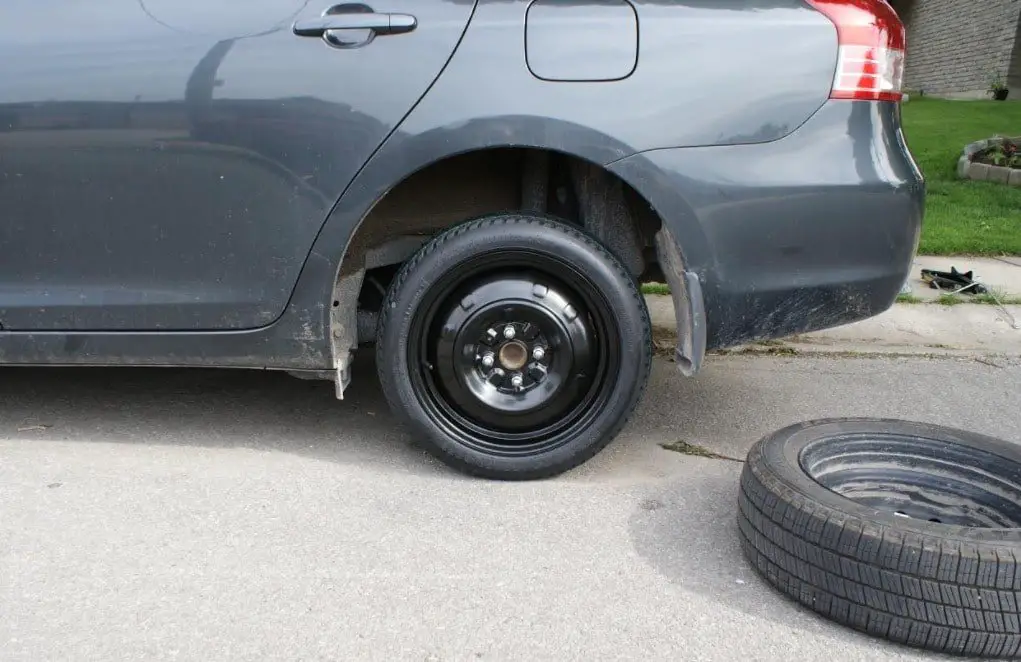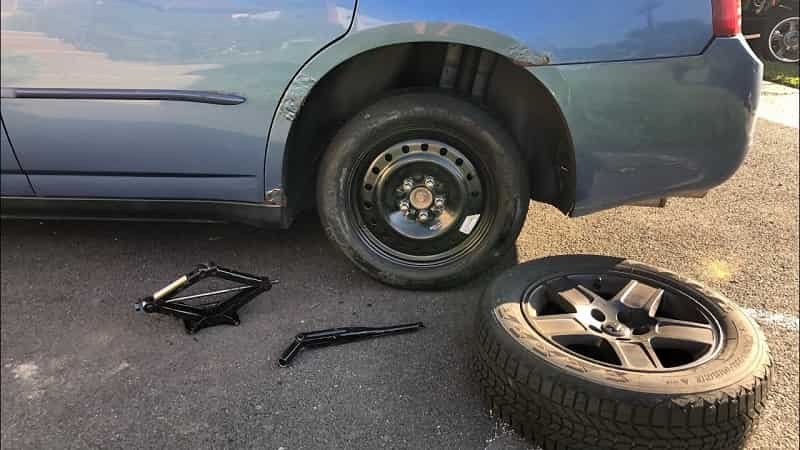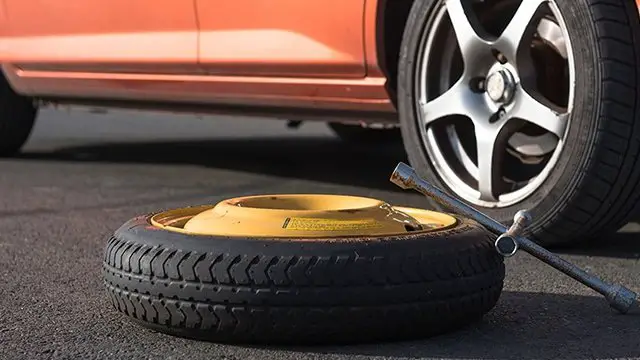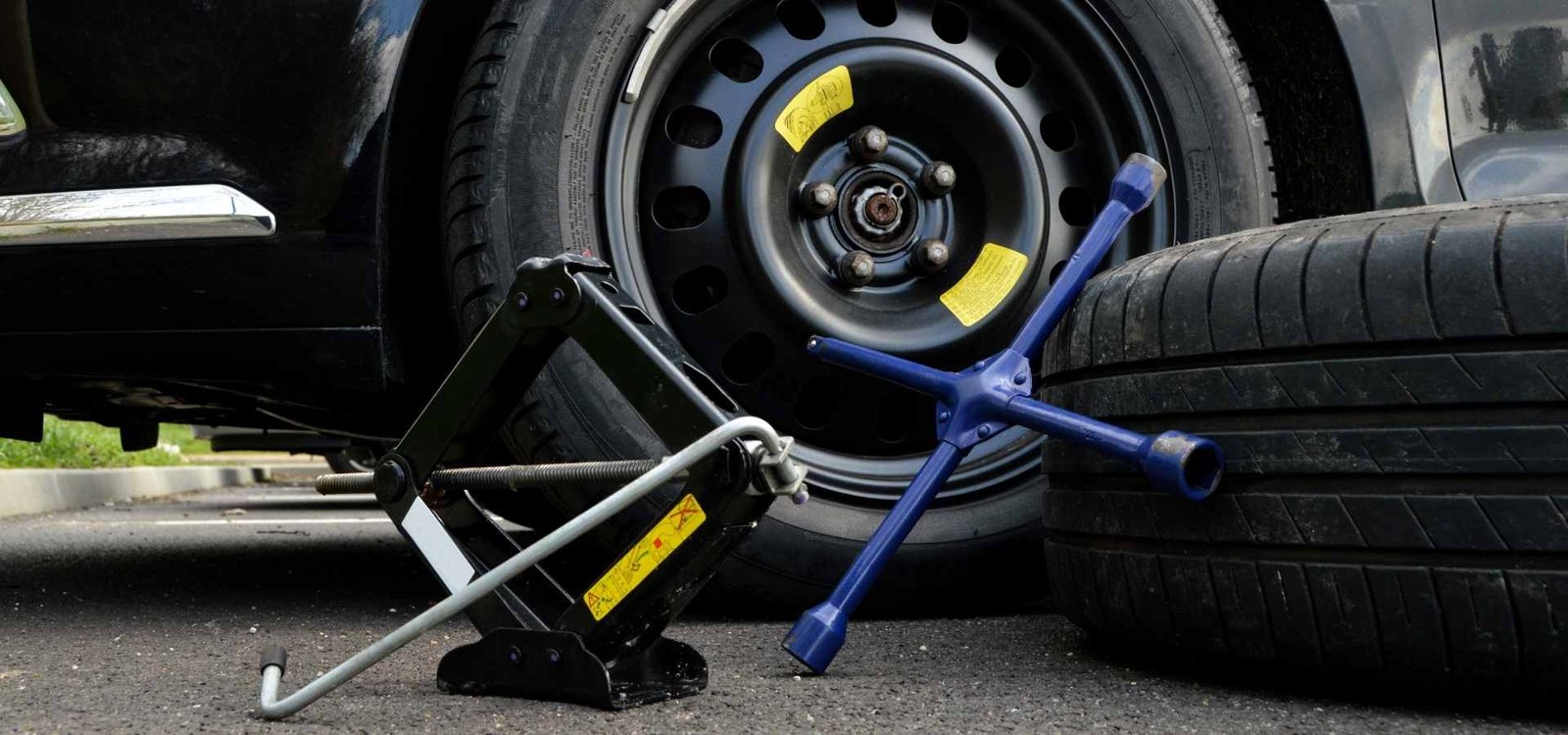In the market for a new set of tires? You may have come across the term “donut tire” and been wondering what it is.
A donut tire, also known as a doughnut tire, is a type of spare tire that is shaped like a doughnut. Donut tires are typically used as temporary spares, or “space savers,” to get you through until you can replace your regular tires.
But can you actually drive 200 miles on a donut tire? And are they safe to use? Here’s what you need to know about donut tires.
What's in this post?
What is a donut tire and how does it work?

A donut tire (or doughnut tire) is a small, temporary spare tire that is used to replace a flat or damaged tire.
Donut tires are typically only meant to be used for short distances at low speeds, as they have a smaller circumference than regular tires and are not meant for high-speed driving.
While donut tires can be a lifesaver in an emergency situation, it is important to know how to properly use them to avoid further damage to your vehicle.
When driving on a donut tire, always go slowly and avoid sharp turns or sudden stops. If possible, avoid driving on rough roads or in bad weather.
If you must drive on a donut tire for an extended period of time, have the tire checked by a professional as soon as possible.
Can I drive 200 miles on a donut tire?

The short answer is no, you cannot drive 200 miles on a donut tire. A donut tire, also known as a spare tire, is only meant to be used for a short distance until you can replace the damaged tire with a new one.
The reasoning behind this is that donut tires are smaller than standard tires, which means they have less contact with the ground. This can lead to instability and decreased handling, both of which can be dangerous at high speeds.
In addition, donut tires are not meant to be driven long distances because they tend to overheat quickly. So while it may be tempting to try and save money by driving on a donut tire, it’s simply not worth the risk.
How long can you drive with a donut tire?
Driving on a donut tire is not ideal, but it can be done in a pinch. It is important to note, however, that you should only drive for a maximum of 50 miles at 50 mph when on a donut tire.
This will help to prevent further damage to the tire and allow you to get to a safe location where you can change the tire. Driving on a donut tire for an extended period of time can cause the tire to overheat, which can lead to a blowout.
In addition, driving too fast on a donut tire can also cause the tire to fail. So if you find yourself in a situation where you have to drive on a donut tire, be sure to take it slow and steady.
Useful read: Who Makes Mastercraft Tires? Are They Good?
How do I know if my spare tire is a donut?
One way to tell if your spare tire is a donut is by checking the tread. Donut spares have virtually no tread, which can make them dangerous to use on wet or icy roads.
Another way to tell is by looking for siping. Siping is little grooves in a tire that help increase traction. Donut spares typically don’t have siping, which means they may not be as effective in snow or mud.
If you’re not sure whether your spare tire is a donut, it’s best to check with your manufacturer or dealer. They’ll be able to tell you for sure and, if necessary, help you find a replacement.
How to change a donut tire

If you find yourself with a flat tire and a donut spare, don’t panic. Changing a donut tire is relatively simple and can be done in a few easy steps.
- Park your car in a safe location away from traffic. Next, loosen the lug nuts on the damaged tire using a lug wrench. Once the lug nuts are loose, use your hands to remove them completely.
- Place the jack under the car and raise it until the damaged tire is off the ground. Carefully remove the damaged tire and place it on one side.
- Take the donut spare and line it up with the empty space where the damaged tire was. Once the donut is in place, put the lug nuts back on and tighten them by hand.
- Lower the car back down and use the lug wrench to tighten the lug nuts as much as possible. Once the lug nuts are tight, you’re ready to hit the road.
Just remember, when driving on a donut tire, take it slow and avoid sharp turns or sudden stops. And be sure to get the damaged tire fixed as soon as possible.
Tips for driving long distances with a donut tire
Driving long distances with a donut tire may not be the best idea. Here are some tips to keep in mind if you must drive long distances with a donut tire:
- Avoid highways if possible. The higher speeds will put more stress on the tire, which could cause it to fail.
- Take it easy on the gas and brakes. Sudden acceleration or braking can place additional strain on the tire, which again, could cause it to fail.
- Pay attention to your speed. Keeping your speed at or below 50 miles per hour will help to reduce stress on the tire.
- Keep an eye out for potholes and other potential hazards. Hitting a pothole at high speeds could damage the tire beyond repair.
If you must drive long distances with a donut tire, following these tips will help to ensure that you get to your destination safely.
Useful read: Over Inflated Tire Symptoms and How is It Bad to Your Car
Pros and cons of using a donut tire on a car
There are both pros and cons to using a donut tire on a car. Some of the pros include:
- A donut tire can be used in a pinch if you have a flat tire and need to get to a safe location.
- Typically smaller and lighter than a regular tire, which can be helpful if you’re stuck in the mud or snow.
- Help you save money if you’re low on cash and need a temporary fix.
Some of the cons of using a donut tire include:
- A donut tire is not meant for long-term use and should only be used as a temporary fix.
- Has very little tread, which can make it dangerous to use on wet or icy roads.
- Doesn’t have siping, which means it may not be as effective in snow or mud.
How long does a donut tire last?
It’s a common question, and one that has no definitive answer. The lifespan of a donut tire depends on a variety of factors, from the quality of the tire to the way it’s used.
In general, however, most donut tires will last between 30 and 50 miles or 10 years if it’s never used, whichever comes first. This may not seem like much, but it’s enough to get you to safety in case of a flat tire or to the nearest service station for a replacement.
Of course, the exact distance you can travel on a donut tire will vary depending on your driving habits and the road conditions.
If you’re driving on rough roads or at high speeds, your donut tire is likely to wear out more quickly. Similarly, if you’re driving carefully and sticking to smooth roads, you may be able to get a bit more mileage out of your donut tire.
Ultimately, it’s important to use your best judgement when deciding how far to drive on a donut tire. If you’re unsure, it’s always better to err on the side of caution and replace your tire as soon as possible.
Will a donut tire fit any car?
No, in order for a donut tire to fit a car, the car must use the same size and style of tire. Otherwise, the donut tire will not fit the car. While some cars may have different sized tires on the front and back, they will still generally be the same style of tire.
Therefore, if a car uses a different style of tire than what the donut tire is designed for, the donut tire will not fit the car. It is important to know what size and style of tire your car uses before purchasing a donut tire, as different cars require different types of tires.
Purchasing a donut tire that is not compatible with your car can result in costly repairs or even accidents. Therefore, it is always best to consult with a professional before purchasing a donut tire.
Other alternatives to using a donut tire on a car during an emergency situation?

There are other alternatives to using a donut tire on a car during an emergency situation. One option is to use a spare tire. A spare tire is a full-sized tire that is typically stored in the trunk of a car.
Spare tires are usually used in place of a flat tire, and can be used for the duration of a car’s life. Another option is to use a flat tire repair kit.
A flat tire repair kit is a temporary fix that allows you to drive your car on a flat tire until you can get to a service station or replace the tire. Flat tire repair kits typically come with a can of sealant and an air compressor.
To use the kit, you simply add the sealant to the flat tire and use the air compressor to inflate the tire. While this is not a permanent fix, it will allow you to drive your car until you can get to a service station or replace the tire.
Useful read: Can You Put Air in a Nitrogen Tire?
How much is a donut spare tire?
The cost of a donut spare tire varies depending on the type of tire and the make and model of the car. In general, however, most donut tires cost between $50 and $300.
While this may seem like a lot of money, it’s important to remember that a donut tire is only meant to be used as a temporary fix. Therefore, it’s not worth skimping on quality when it comes to purchasing a donut tire.
What is the best way to store a donut spare tire?
There are several ways to store a donut spare tire. One option is to keep it in the trunk of your car. This is generally considered to be the safest option, as it prevents the tire from being damaged by road debris or other objects.
Another option is to keep the tire in a garage or shed. This is a good option if you have limited space in your trunk, but it is important to make sure that the tire is protected from the elements.
Finally, some people choose to keep their donut spare tire in their home. This is not generally considered to be the best option, as the tire can be damaged by pets or children.
However, if you have a safe place to store the tire, this may be an option for you. Ultimately, the best way to store a donut spare tire is in a safe and protective location where it will not be damaged.
FAQs
What is the difference between a spare tire and a donut tire?
A spare tire is a full-sized tire that is mounted on a matching rim. A donut tire, also called a space saver or mini-spare, is a smaller, temporary tire that is meant to be used only for short distances.
The main difference between the two is their size; a spare tire is the same size as the other tires on the vehicle, while a donut tire is smaller.
This means that a donut tire will not provide the same level of performance as a spare tire. For example, a donut tire may not be able to support the same weight load as a spare tire, and it may have a lower speed rating.
As such, it is important to only use a donut tire in an emergency situation and to replace it with a spare tire as soon as possible.
Can you reuse a donut tire?
Yes, you can reuse a donut tire. However, it is important to only use the tire for the amount of time specified by the manufacturer.
Additionally, it is important to inspect the tire before using it again to ensure that it is still in good condition. If the tire shows any signs of wear or damage, it should be replaced with a new one.
Which side of donut tire faces out?
When mounting a doughnut tire on a vehicle, it is important to ensure that the valve stem is facing in the correct direction.
The valve stem is the part of the tire that is used to inflate or deflate the tire, and it should therefore be positioned so that it is easily accessible.
For this reason, the valve stem should be facing outwards, away from the vehicle. This will ensure that the stem is not obstructed by the wheel well, and that it can be easily reached in the event that the tire needs to be inflated or deflated.
While it may seem like a small detail, mounting a doughnut tire with the valve stem in the correct position can make a big difference in terms of convenience and safety.
Can you put air in a donut tire?
Yes, you can put air in a donut tire. However, it is important to only inflate the tire to the maximum pressure specified by the manufacturer.
Overinflating the tire can cause it to burst, which can lead to serious injury. Additionally, overinflating the tire may cause the tire to wear out more quickly.
What happens if you drive on a donut too long?
Driving on a donut for too long can put a lot of strain on the engine and transmission.
The smaller size of the donut means that the engine has to work harder to turn the wheels, and the transmission has to work harder to deliver power to the wheels.
This can cause premature wear and tear on both the engine and transmission, and can eventually lead to expensive repairs.
Additionally, driving on a donut for extended periods of time can negatively impact fuel economy.
How do you tell if your tire is a donut?
There are a few ways to tell if your tire is a donut.
First, check the sidewall of the tire. If it is marked “not for highway use,” then it is likely a donut.
Second, measure the width of the tire. If it is less than six inches, it is probably a donut.
Finally, look at the tread pattern. Donuts typically have shallow treads with wide spaces between them. If you see these features on your tire, it is likely a donut.
Can a doughnut tire go flat?
Yes, a donut tire can go flat.
However, because they are smaller and have shallower treads, they are more susceptible to flats than regular tires.
If you have a flat donut, it is important to replace it with a spare tire as soon as possible. Driving on a flat donut for extended periods of time can damage the engine and transmission.
Why do cars come with donuts?
Cars come with donuts because they can be used in an emergency situation.
If a car has a flat tire, the driver can put a donut on the car and drive it to a safe location.
Additionally, donuts are much easier to change than regular tires. This makes them ideal for use in an emergency situation when time is of the essence.
Finally, donuts are much cheaper than regular tires. This makes them an attractive option for budget-conscious consumers.
Is it better to have a donut on the front or back?
The front wheels of a vehicle often bear more weight than the back wheels. This is because the engine is typically located in the front of the vehicle. Having a donut tire on the front wheels would therefore put more stress on the tire, potentially causing it to fail.
It is also worth noting that the front wheels of a vehicle are typically responsible for steering. Having a donut tire on the front wheels would therefore make steering more difficult, which could be dangerous.
For these reasons, it is generally advisable to have a donut tire on the back wheels rather than the front wheels.
Where to buy donut tires?
There are a few different places where you can buy donut tires.
First, you can check with your local automotive store. Many stores that sell tires also sell donuts.
Second, you can check with your local salvage yard. Salvage yards typically have a wide selection of used tires, including donuts.
Finally, you can check online. There are a number of websites that sell new and used tires, including donuts.
When buying a donut tire, it is important to make sure that the tire is the correct size for your vehicle. Additionally, it is important to check the condition of the tire before purchasing it.
Conclusion
A donut tire, or doughnut tire, is a temporary spare tire that is typically smaller in size and has less air pressure than a standard tire. This allows it to be driven on when it is flat, as the air pressure inside holds it up.
Donut tires are used to get drivers back on the road quickly when they experience a flat.
While donut tires can be driven for short distances, it is important to remember that they are not meant for long-term use. If you experience a flat while driving on a donut tire, be sure to replace your spare as soon as possible.





